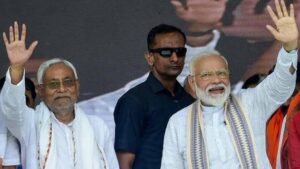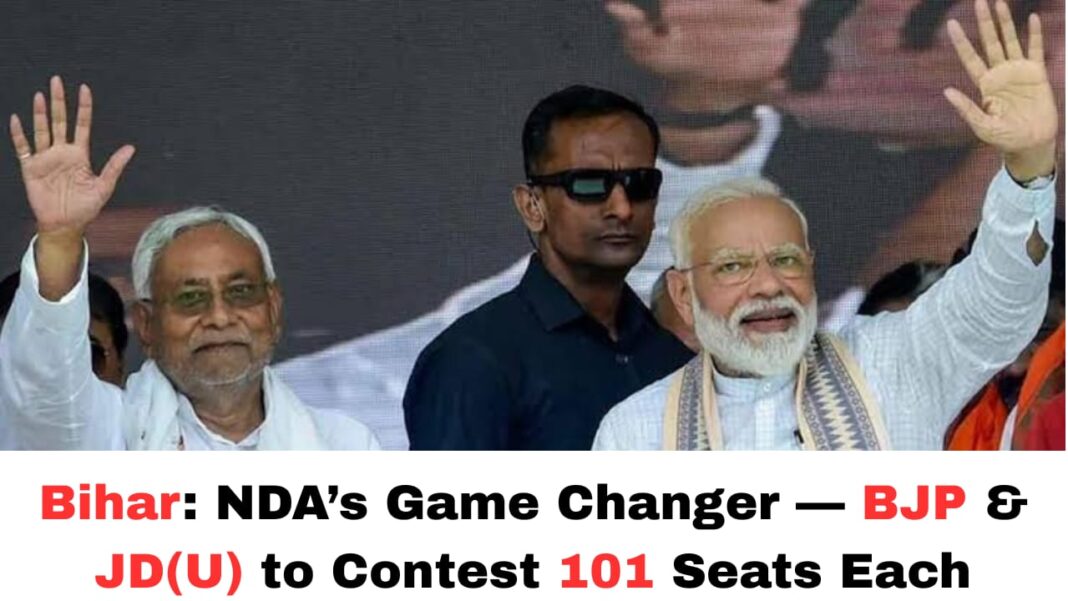Digital News Guru Bihar Desk:
BJP and JD(U) Share Power on Equal Terms: NDA Finalizes 101-101 Seat Deal in Bihar
In a departure from past alliances and seat negotiations, the National Democratic Alliance (NDA) has announced a fresh power balance for the 2025 Bihar Legislative Assembly elections: the Bharatiya Janata Party (BJP) and Janata Dal (United) (JD(U)) will each contest 101 seats out of the total 243.
This marks a notable shift: for perhaps the first time in recent memory, two principal NDA partners in Bihar are contesting on equal footing—rejecting the conventional “senior” and “junior” partner dynamic. This arrangement is widely interpreted as not just a tactical adjustment but a re-calibration of political clout within the alliance in Bihar.

What the Full NDA Distribution Looks Like
Alongside BJP and JD(U), the other NDA partners have also been allotted their share of seats:
- Lok Janshakti Party (Ram Vilas) [LJP(RV)]: 29 seats
- Hindustani Awam Morcha (HAM): 6 seats
- Rashtriya Lok Morcha (RLM): 6 seats
Thus, the pact covers all 243 seats in the assembly.
The allocation reflects both the desire of BJP to expand its strength in Bihar and the evolving dynamics within the alliance. Media commentary notes that this equal sharing signals a “no big brother” approach this time around.
Why This Matters: Strategic and Political Implications
Rebalancing power in the alliance
Historically, JD(U) has played a dominant role in Bihar’s NDA equation, often regarded as the larger partner in state politics. But this time, the BJP is explicitly pushing for parity. By matching seat numbers, BJP is signaling stronger confidence in its ability to fight independently, even within an alliance.
Some analysts interpret it as BJP hedging its bets: if the alliance holds, BJP claims a stronger share of the victory; if things go awry, it may have more leeway to reposition itself. Others view it as recognition that JD(U)’s mobilizational machinery, particularly in its traditional strongholds, is no longer enough on its own.

The role of LJP (Chirag Paswan) and smaller allies
The LJP has emerged as a relatively strong negotiator in the process. Its allocation of 29 seats is significant compared to previous elections, especially given its bargaining posture in early talks.
However, Paswan’s demands were reportedly more aggressive: at one point, LJP pushed for 40 seats. That demand had met resistance, and the final number reflects compromise and alliance constraints.
HAM and RLM, being smaller players, have been allotted relatively modest numbers (six seats each). While these allocations may appear peripheral, in a tightly contested election they could become pivotal — especially if the major parties’ margins are narrow.
Messaging to voters and internal cohesion
By going for parity, BJP and JD(U) also send a message internally: no one party will overshadow the other. That helps in managing egos, candidate claims, and intra‐alliance resentment. Some local leaders in media discussions have already framed this as a more “balanced” coalition.
At the same time, it raises questions about how victories will translate into influence and administrative control—especially in zone distributions, ministerial posts, or seat-sharing in future elections.
Challenges Ahead and Risk Factors
- Ticket distribution friction: With equal numbers to contest, both BJP and JD(U) will inevitably face internal stresses over which seats to field, which sitting MLAs to give tickets, and which to deny. Already, reports suggest some veteran MLAs (especially from JD(U)) may lose tickets under the new deal.
- Vote transfer and alliance discipline: In many constituencies, the success of one NDA partner may depend on transfer of votes from allied parties. If the loyalty of smaller partners or voter coordination fails, the split could hurt the alliance’s overall performance.

- Opposition strategies: The Mahagathbandhan (or broader INDIA bloc) will try to exploit any cracks. If opposition forces can shift the narrative to internal discord or betrayal in the alliance, it could hurt NDA’s image in swing seats.
- Campaign resource allocation: With both BJP and JD(U) contesting aggressively, they may compete for common resources—funds, ministers for campaigning, central support, media attention, and logistics. Ensuring equitable distribution will test internal management.
Broader Context: Bihar’s Political Landscape in 2025
The 2025 Bihar election is being held in two phases (November 6 and November 11). The NDA clearly sees this seat-sharing as the foundation for its campaign structure and messaging. With caste equations, development agendas, and national narratives all in play, the alliance dynamics set now could reverberate throughout the campaign.
In recent years, Bihar politics has seen shifting allegiances, defections, and renegotiations. One notable recent event was Nitish Kumar’s reentry into NDA from the opposition bloc in early 2024—an upheaval that reset many equations in the state.
Ultimately, while the 101-101 agreement is novel and symbolically strong, its success will hinge on execution: maintaining alliance discipline, translating seat allocations into victories, and managing post-election fallout.
You May Also Read: All-India Police Weightlifting Competition Begins in Amaravati with Over 1,000 Participants








